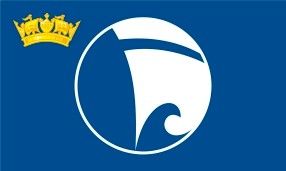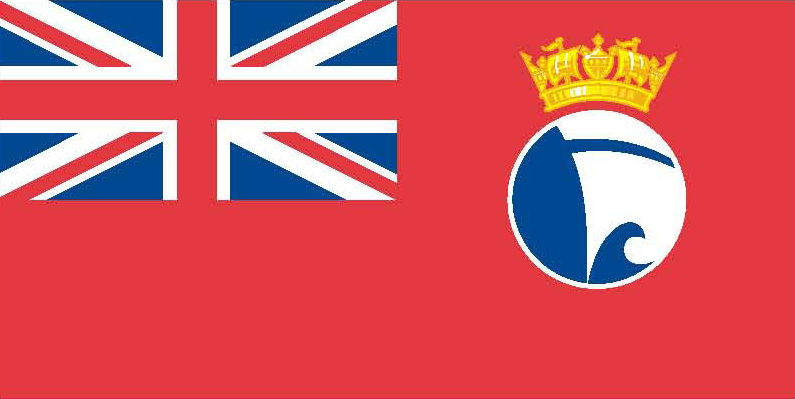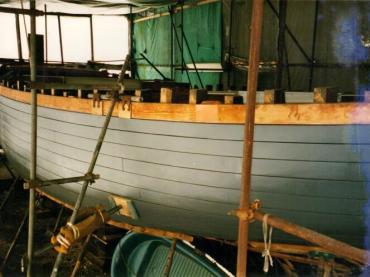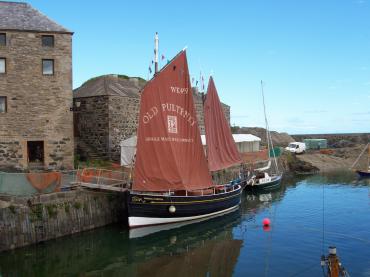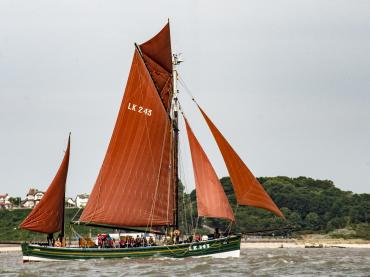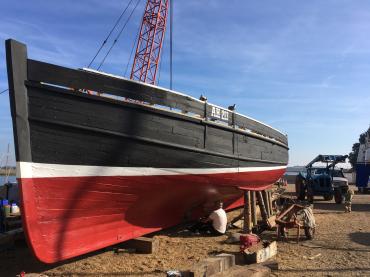Previous names
- 1959 - 1975 Shetlander
Details
Construction
Dimensions
History
REAPER is a Fifie sailing herring drifter, an example of the most popular design of fishing boat on the East Coast of Scotland for the greater part of the 19th and early 20th centuries. Originally built as a two masted sailing lugger by J & G Forbes of Sandhaven, near Fraserburgh, she is 70 feet long with a dipping lug foresail and a standing lug mizzen.
First registered at Fraserburgh in 1902 (FR 958), REAPER moved to Shetland and was registered at Lerwick in 1908 (LK 707) where she had great success at the summer herring fishing. In the late 1930s she held the record catch of herring for Shetland, some 223 cran – almost a quarter of a million fish.
She continued fishing until the outbreak of the Second World War when she was requisitioned by the Admiralty and saw service in the south of England. After the war she returned to fishing in Shetland and was working until 1957. In 1959 she was purchased by Zetland County Council for use as a ‘flit-boat’ carrying general cargoes and renamed Shetlander. She was retired in 1974 after the introduction of the Ro-Ro ferries and was subsequently purchased by the Scottish Fisheries Museum in 1975.
During the following years she was restored to her original 1902 rig and renamed REAPER FR 958. As Flagship of the Scottish Fisheries Museum, REAPER is the last surviving First Class sailing lugger of the ‘Fifie’ type and is now the sole example of a once prolific type of vessel. She is normally berthed in Anstruther harbour, close to the Museum, equipped as a floating museum of the now diminished herring industry. She also visits ports around Scotland and Northern England on cultural tours and has appeared in several films and television programmes.
From 2017, the Museum embarked on a major conservation project conducted by Adam Way and Babcock International, with major funding from the Scottish Government. Work by the volunteer members of the Boats Club with professional support from boatbuilder Ali Beedie continued in Anstruther Harbour and was recognised in 2020 with the Martyn Heighton Award for Excellence in Maritime Conservation. By Summer 2023, the Reaper was once again able to go to sea to resume her work engaging people around Scotland with maritime heritage.
This vessel is a survivor from the First World War. You can read more about her wartime history by visiting our First World War: Britain's Surviving Vessels website www.ww1britainssurvivingvessels.org.uk.
We are currently seeking further information on this National Historic Fleet vessel. If you have any details about this vessel past or present, please contact us.
Significance
1. What is the vessel’s ability to demonstrate history in her physical fabric?
Evidence for designs, functions, techniques, processes, styles, customs and habits or uses and associations in relation to events and people. How early, intact or rare these features are may impact on significance.
REAPER was originally built in 1901 as a two masted sailing lugger. She is 70 feet long with a dipping lug foresail and a standing lug mizzen. She is a typical Scottish sailing herring drift net fishing vessel, of which two types evolved, known locally as ‘fifies’ and ‘scaffies’. Both the scaffies and fifies were two-masted double-enders, mostly lug rigged with shallow bulwarks. REAPER is a large fifie, an example of the most popular design of fishing boat on the East Coast of Scotland for the greater part of the nineteenth and early twentieth centuries. She represents the ultimate development in sailing drifter design, with large sails and heavy gear made possible by the steam capstan first introduced in the 1880s. REAPER’s steam capstan, which remains operational, was made in the 1920s by McDonald Brothers of Portsoy. Whilst in Shetland post 1908, REAPER was converted to a smack rig. In 1916, she was fitted with a Gardner 4KM engine. This was a four stroke engine producing 75bhp running on paraffin with lamp heated vaporisers. After her purchase by the Scottish Fisheries Museum in 1975, her original rig was reinstated over a ten year period and she was renamed REAPER FR 958. An extensive refit was carried out between October 2004 and April 2005 by MacKay Boatbuilders (Arbroath) Ltd. Repairs included a new keel, new Daewoo engine and new masts of Douglas Fir.
2. What are the vessel’s associational links for which there is no physical evidence?
Associations with people or places. Off-ship research.
REAPER’s history is integral with that of the Scottish fishing industry. She was launched in 1903 at the J. & G. Forbes Boatyard in Sandhaven near Fraserburgh where she was registered as FR 958. She moved to Lerwick in Shetland in 1908 and became LK 707. Her story during the First World War illustrates the vital role played by the fishing fleet at this time, when fish constituted a substantial part of the nation’s diet. The installation of REAPER’s engine in 1916 also reflects her war-time role. With fishing restricted to daylight hours because of the danger of enemy action, the engine became a necessity to ensure she could be back in harbour before dusk. In the late 1930s REAPER held the record catch of herring for Shetland, some 223 cran – almost a quarter of a million fish. She is significant for playing a part in the Second World War, when she was requisitioned by the Admiralty and saw service in the south of England. REAPER’s other role as a working vessel came in 1959 when she was purchased by Zetland County Council and employed as an inter-island cargo vessel in the Western Isles, a ‘flit-boat’ carrying general cargoes and renamed SHETLANDER. REAPER has appeared in several films and television programmes and is well documented in the Scottish Fisheries Museum’s archives. She has been recorded on the National Register of Historic Vessels since 1996 and has National Historic Fleet status.
3. How does the vessel’s shape or form combine and contribute to her function?
Overall aesthetic impact of the vessel, her lines, material she was built from and her setting. Does she remain in her working environment?
The primary function of REAPER was as a fishing vessel and she was purpose built of larch planking on oak frames, with heavy gear intended for the adverse sailing and fishing conditions she would encounter in the North Sea and the east coast of Scotland. Her design, construction and rig made her perfectly fit for purpose. As a fast and efficient fishing vessel she presented an elegant, graceful and pleasing sight when under sail. As flagship of the Scottish Fisheries Museum at Anstruther, REAPER is maintained in sea-going condition and operates a full sailing programme between May and October each year. She acts as a high-profile ambassador for the Museum, vising ports and harbours around Scotland and Northern England where she would once have fished.
Source: NHS-UK team, 15 February 2017.
This statement was developed as part of the Heritage Lottery funded First World War project. http://www.ww1britainssurvivingvessels.org.uk/
Key dates
-
1901
Built by J. & G. Forbes Ltd of Sandhaven, Scotland
-
1902
Registered in Fraserburgh as FR958
-
1908
Registered in Lerwick as LK707
-
1916
Fitted with a Gardner engine
-
1930s
Recorded a record catch of herring for Shetland (some 223 cran)
-
1939-45
Requisitioned by the Admiralty for service in SE England
-
1945-57
Continued fishing in Shetland
-
1959
Purchased by Zetland County Council for use as a “flit-boat” among the islands and renamed SHETLANDER
-
1974
Retired from service after the introduction of the Ro-Ro ferries
-
1975
Purchased by the Scottish Fisheries Museum and renamed REAPER
-
1975-85
Extensively restored to her original 1902 rig
-
1987
Fitted with a Volvo 120hp engine elevated to 180hp
-
2004-05
Underwent an extensive refit at MacKay Boatbuilders Ltd of Arbroath
-
2006
New masts were fitted and vessel took part in the 13th Scottish Traditional Boat Festival at Portsoy
-
2007
Awarded a grant of £1000 by National Historic Ships for training course for volunteers
-
2011
Engine failed at end of season
Grants
-
April 2007
A Training Grant of £1000 for a training course for volunteers was made from the Strategic Development Fund of National Historic Ships
-
2004/05
The Heritage Lottery Fund awarded £117,000 to the vessel
Sources
Scottish Fisheries Museum, Reaper FR958: Fifie Lugsail Herring Drifter, St Ayles Press, 2024, ISBN 978-0-9543869-9-3
Reaper FR958 information leaflet, Scottish Fisheries Museum
Brouwer, Norman J, International Register of Historic Ships, Anthony Nelson, Edition 2, 1993
Sullivan, Dick, Old Ships, Boats and Maritime Museums, Coracle Books, 1978
Walker, Alastair, The Fleet: a guide to the historic vessels at the Scottish Fisheries Museum, St Ayles Press, 2002
Own this vessel?
If you are the owner of this vessel and would like to provide more details or updated information, please contact info@nationalhistoricships.org.uk

